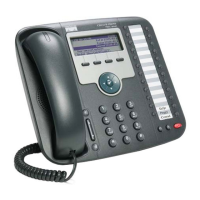1-22
Cisco Unified IP Phone 7931G Administration Guide for Cisco Unified Communications Manager 8.0 (SCCP and SIP)
OL-20798-01
Chapter 1 An Overview of the Cisco Unified IP Phone
Overview of Configuring and Installing Cisco Unified IP Phones
4. Add and configure directory numbers (lines) on the phone by
completing these required fields in the Directory Number
Configuration window.
• Directory number(s)
• Partition
• Multiple Calls and Call Waiting
• Call Forwarding and Pickup (if used)
• Voice Messaging (if used)
Adds primary and secondary directory numbers and features
associated with directory numbers to the phone.
See the Cisco Unified Communications Manager
Administration Guide, Directory Number
Configuration.
See Telephony Features Available for the Phone,
page 5-2.
5. Customize softkey templates.
Adds, deletes, or changes order of softkey features that display on
the phone.
See the Cisco Unified Communications Manager
Administration Guide, Softkey Template
Configuration.
See Configuring Softkey Templates, page 5-20.
6. Configure speed-dial buttons and assign speed-dial numbers
(optional).
Adds speed-dial buttons and numbers.
Note Users can change speed-dial settings on their phones by
using Cisco Unified CM.
See the Cisco Unified Communications Manager
Administration Guide, IP Phone Configuration.
7. Configure Cisco Unified IP Phone services and assign services
(optional).
Provides IP Phone services.
Note Users can add or change services on their phones by using
Cisco Unified CM.
You must specify a service URL with an IPv4 address.
See the Cisco Unified Communications Manager
Administration Guide, IP Phone Configuration.
See the “Setting Up Services” section on
page 5-21.
8. Assign services to phone buttons (optional).
Provides single button access to an IP phone service or URL.
See the Cisco Unified Communications Manager
Administration Guide, IP Phone Configuration.
9. Add user information by configuring required fields:
• Name (last)
• User ID
• Password (for Cisco Unified CM web pages)
• PIN (for use with Extension Mobility and Personal Directory)
Adds user information to the global directory for Cisco Unified CM.
See the Cisco Unified Communications Manager
Administration Guide, End User Configuration.
See Adding Users to Cisco
Unified Communications Manager, page 5-21.
If your company uses a a Lightweight Directory
Access Protocol (LDAP) directory to store
information on users, you can install and configure
Cisco Unified Communications to use your existing
LDAP directory, see Configuring Corporate
Directories, page 5-17.
Table 1-7 Checklist for Configuring the Cisco Unified IP Phone 7931G in Cisco Unified CM (continued)
Task and Purpose For More Information

